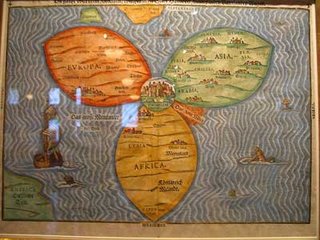 Clover Map, drawn by Heinrich Bunting, 1585. Photo is courtesy of "pianoforte" From Flickr who shot it at Boston, Massachusetts, public library.
Clover Map, drawn by Heinrich Bunting, 1585. Photo is courtesy of "pianoforte" From Flickr who shot it at Boston, Massachusetts, public library.The following paragraph is from Dr. Asher Eder’s book The Star of David, which was published in 1987 in English in Jerusalem byRubin Mass Ltd. The publication here is courtesy of Oren Mass
This version includes corrections and new materials that do not appear on the printed version
Although the geographic connection between the "upper" and "lower" city is obvious, King David gave the link its spiritual dimension. In the time of the First and Second Temple, the Jewish people would literally ascend from the (lower) City of David to the (upper) Temple Mount, which could represent "Heavenly Jerusalem". Everything hinges on it, “earthly Jerusalem” as well as farmers and shepherds, East and West, North and South. A medieval map which shows Jerusalem at the center of the world, has much truth in it
We can well argue that Jerusalem has no other significance than the one given to it by King David.
This double nature of Jerusalem is also reflected in its Hebrew name, Yerushalayim. The ending -ayim usually indicates a dual form. However it is not really a grammatical ending; rather, it belongs to the root of the word שלם, shalem. Nevertheless, the pronunciation supports the duality. And indeed, has any other city proven capable, by its very existence, of uniting the different aspects mentioned above, foremost the earthly with heavenly?
Yet, the first part of the word Yerushalayim, yeru-, is the future plural of the verb yoreh, which can mean to shoot (an arrow), to teach, to point to, or to lay a foundation. Judging from these meanings, as well as from its turbulent history, we can hardly say that Jerusalem i s the city of peace, although its name is often so interpreted. Yerushalayim rather alludes to God's foundation, started ("shot off") to teach us peace, and pointing towards peace, the word peace being understood as not merely an absence of war, but a state of harmony between the earthly and the heavenly within and around us. Thus, the future term yeru expresses rather the hope for that peace.
The same idea is expressed by the word Zion. Its root gives origin to such words as to command, to distinguish, to erect. This means that Zion, by the command of the Most High, is a monument to His Name and Sovereignty. It also marks the spiritual focus within Man, and is an expression of his innermost spiritual longing. Thus, it is a token of the harmony and peace which result from the spiritual rebirth of which the Psalmist sings (in Ps.87):The Lord loves the gates of Zion more
than all the dwelling places of Jacob...
But of Zion it shall be said:
'This one and that one were born in her';
for the Most High Himself will establish her.
The Lord records as He registers the peoples:
'This one was born there (Selah).
When we thus conceive Zion as the unification of the temporal with the Divine, and eventually of the nations with Israel, we may understand that no other symbol expresses this idea as accurately or as beautifully as our six-pointed star with its interwoven triangles. This symbol is justly named after King David, the founder of Zion, Messiah of the Lord).
All this may teach us that dividing Jerusalem, or dividing the country, cannot achieve peace. On the contrary.
No comments:
Post a Comment